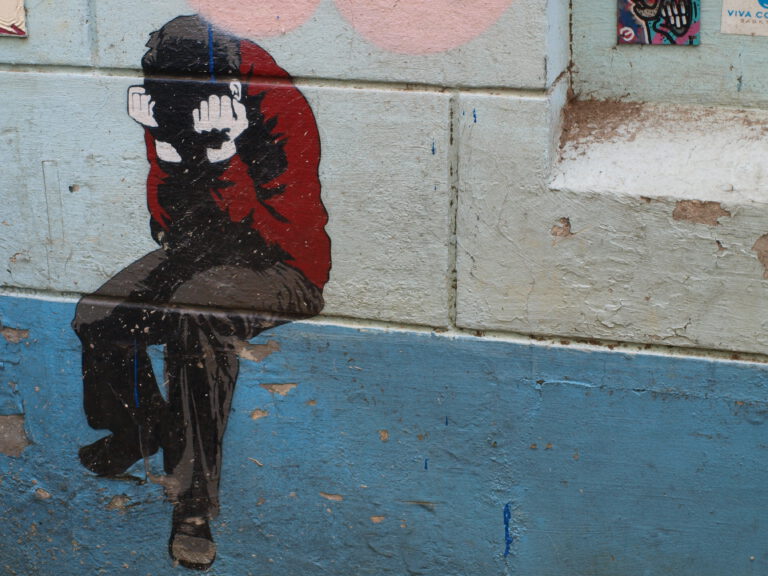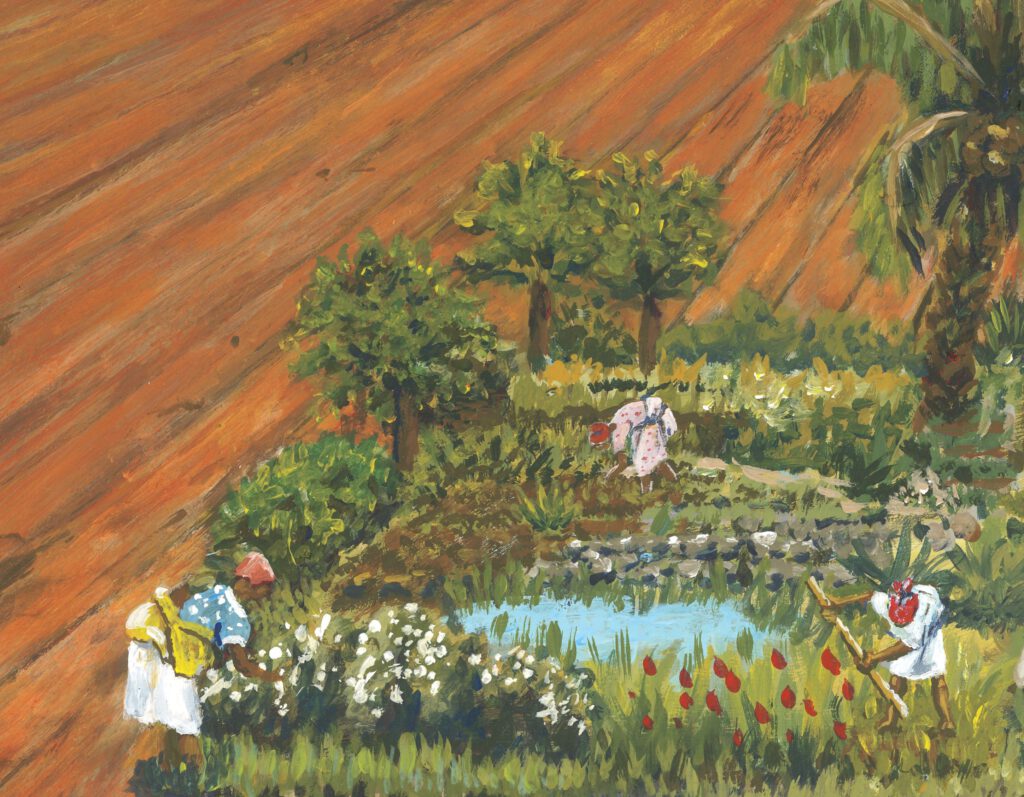SDG 1: End poverty

Poverty means that one does not have enough of urgently needed, (over)life-essential things, or must completely go without them. The condition describes a lack of provision that can be real or perceived as life-threatening.
Poverty is not all the same
Poverty is a multifaceted concept and can refer to a wide range of things or conditions that are insufficient or completely absent. “Being poor” is not a personal trait, but a dynamic process and a context-dependent attribution. It can be temporary, long-term, or permanent and can have individual or structural causes, for example through unequal distribution of resources, limited educational opportunities, or discrimination.
In industrialized societies, poverty is almost always associated with the lack of money, economic resources, and material possessions, and is contrasted with (material) wealth. Those who are materially poor, for example, earn too little to adequately provide themselves with food, clothing, housing, or consumer goods. People living in material poverty often struggle to lead a dignified and equitable life. Social poverty refers to exclusion or disadvantage in social, cultural, or political areas such as education, employment, healthcare, culture, or societal participation.
Consequences of poverty can include hunger, homelessness, health impairments, discrimination, and social exclusion. Those who earn little or nothing have poorer access to education, culture, the labor market, and medical care. Studies show that children from materially poor families perform worse in school than children from wealthier families, even when they achieve the same results.
Poverty can be absolute, relative, or perceived. Absolute poverty refers to a condition in which a person cannot afford to meet their existential – economic and social – basic needs. People living in extreme poverty have (according to the UN definition) less than the equivalent of 2.15 US dollars per day at their disposal. These individuals must struggle simply to survive.

Relative poverty describes poverty in relation to the surrounding social environment. It refers to social inequality and class-based societal structures. People are considered relatively poor if their income is significantly lower than the average median income of the rest of the population in a country – depending on the approach, this can be 40–60%.
In contrast, perceived poverty is not based on a calculable monetary value. People feel poor because they experience discrimination, perceive a certain lack, or see themselves as disadvantaged. Perceived poverty is not about income or material goods, but about social participation: it is a question of socio-cultural perception. Someone who is considered poor by others can still feel rich in terms of relationships, health, creativity, happiness, and satisfaction.
Extreme inequality: numbers and facts
The goal of SDG 1 is to completely eradicate extreme poverty worldwide by 2030 and to at least halve the number of people living in poverty – measured according to national definitions. However, based on current development trends, only about a third of countries worldwide are expected to achieve the target of halving poverty by 2030.
Since the 1990s, poverty reduction has made some progress: for more than 20 years, the number of people living in poverty worldwide steadily declined. Since 1990, over one billion people have been lifted out of extreme poverty.
However, as a result of the COVID-19 pandemic, extreme poverty has increased again, partially reversing previous progress. According to the United Nations, around 1.4 billion people worldwide were living in extreme poverty in 2023. More than 4 billion people have no social protection at all.
The pandemic has also further intensified global income inequality. The gap between rich and poor continues to grow: the wealth of the world’s ten richest billionaires has increased by an average of $100 million per day since 2020 – the five richest men in the world have more than doubled their wealth. A handful of the wealthy now control as much wealth as the poorer half of the world population combined. Meanwhile, the poorest five billion people lost billions during the same period.
Even in Germany, the richest individuals are becoming richer, and inequality is increasing: the total wealth of the five richest Germans grew, adjusted for inflation, by around three-quarters from approximately $89 billion to about $155 billion since 2020. Germany also has, after the USA, China, and India, the highest number of billionaires (OXFAM 2024).
Besides the pandemic, the climate crisis is a major driver of poverty. The same applies to violent conflicts and their consequences, such as in Syria, Yemen, Ukraine, and the Middle East. Women, children, indigenous groups, people with disabilities, LGBTQ+ persons, and other marginalized populations are particularly affected by poverty.
In Germany, around 15% of the population was at risk of poverty in 2023 – approximately 13 million people. This mainly includes children, elderly people, and immigrants. Almost one in four children lives in a household that is economically affected by poverty (German Youth Institute, 2023). This is ethically and socially unacceptable and carries significant political implications.

Excessive wealth destroys the social foundations of a democracy and makes society increasingly unjust. In addition, wealthy people have been shown to contribute significantly more to resource consumption and CO₂ emissions – and thus to the climate and biodiversity crisis – than poorer people. A higher wealth tax could counteract this, improve the state budget, allow for greater investment in education, health, and climate protection, and thus create more justice.
Eurocentric concept of poverty
In principle, poverty is a social phenomenon, a condition of severe social disadvantage. However, the associated lack of provision with material goods and services is judged very differently. A standard measure of poverty is usually household income or the lack of economic resources. This leads to self-sufficient people, such as indigenous populations – even if they do not suffer material or social deprivation – being inevitably counted among the poor:
“People who eat millet instead of commercially produced industrial junk food are called poor. People are considered poor just because they live in houses they built themselves. The material they use comes from nature: bamboo, clay, straw, wood – instead of cement. People are considered poor because they wear handmade clothing made from natural materials rather than synthetic textiles.” (abridged from Vandana Shiva, 2005)
This today-common Eurocentric definition of poverty, combined with the enormous material wealth of industrialized countries, leads to a distorted perception. Because if certain people assign little value to material goods and own few of them, they are by no means to be called poor.
In this regard, SDG 1 falls significantly short.
And this is exactly where the mural by Eckart Keller comes in.

The targets of SDG 1 are…
To ensure that all people are covered by social protection according to national circumstances and to achieve broad provision for the poor and vulnerable.
To provide all people with equal rights and opportunities in access to basic services, wealth, land, natural resources, as well as appropriate new technologies and financial services.
To strengthen the resilience of people living in poverty to climate-related extreme events and economic, social, and environmental shocks.
To provide adequate funding for programs aimed at ending poverty in all its dimensions and to create (inter-)national policy frameworks for the development of poverty-oriented and gender-sensitive strategies to eliminate poverty.
To promote the participation of people living in poverty in political decision-making as well as in social, economic, and cultural life.
In Hamburg
Hamburg is one of the wealthiest cities in Germany, with the highest density of millionaires. Nevertheless, the risk of poverty here is significantly above the national average. According to the 2024 Poverty Report of the Paritätischer Wohlfahrtsverband, nearly 20% of residents are affected by poverty. This is the third highest rate in Germany, after Bremen and North Rhine-Westphalia. In addition, poverty is currently growing faster in Hamburg than anywhere else in Germany. While the national poverty rate stagnated, it increased in Hamburg by an alarming eleven percent.
Compared to other major cities in Germany, Hamburg has the highest number of homeless people: according to the Federal Statistical Office, at the beginning of 2023 there were more than 32,000 homeless people in urban shelters – 70 percent more than the previous year. One reason for the sharp increase was the influx of people fleeing the war in Ukraine.
Further websites:
- SDG 1: Text and further information: https://www.bmz.de/de/agenda-2030/sdg-1
- Global wealth inequality / country list: https://de.wikipedia.org/wiki/Gini-Koeffizient
- Oxfam, Inequality Report 2024: https://www.oxfam.de/themen/soziale-ungleichheit
- German Youth Institute, Child Poverty in Germany 2024: https://www.dji.de/fileadmin/user_upload/bibs2024/DJI_Abschlussbericht_Befragung_KGS_2024.pdf
- Paritätischer Wohlfahrtsverband: Poverty Report 2024: https://www.der-paritaetische.de/fileadmin/user_upload/Publikationen/img/Paritaetischer_Armutsbericht_2024.pdf
- Inequality in Germany: https://krautreporter.de/geld-und-wirtschaft/5283-diese-sieben-grafiken-zeigen-wie-ungleich-deutschland-ist?utm_campaign=pocket-visitor
- Interim assessment of SDG 1 by the Global Policy Forum (2020): https://www.2030agenda.de/sites/default/files/2030/zwischenbilanz/Agenda_2030_Zwischenbilanz_Ziel_01.pdf
- National Poverty Conference – Shadow Report 2025: Poverty in Germany – https://www.nationale-armutskonferenz.de/2025/01/27/schattenbericht-2025-armut-in-deutschland
Get involved:
- Campaign: Tax the Rich – https://www.attac.de/kampagnen/tax-the-rich/kampagne-tax-the-rich
- Tafel Germany: The food banks save food that can no longer be sold and distribute it to people living in poverty, who often cannot afford a balanced diet. https://www.tafel.de
- Oxfam: Oxfam brings together people worldwide who refuse to accept poverty and extreme inequality. In crises and disasters, they provide life-saving emergency aid. https://www.oxfam.de/
- German Caritas Association, German Red Cross, Johanniter, Arbeiterwohlfahrt, Diakonisches Werk, Deutsches Kinderhilfswerk, and other nonprofit and church organizations provide support through food donations, counseling, educational programs, childcare, cold-weather aid, and other services for people at risk of poverty. They all need volunteers, support, and donations. A list of organizations can be found here: https://www.nationale-armutskonferenz.de/ueber-uns/mitgliedsorganisationen